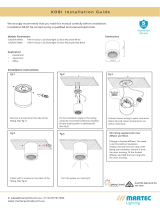
OMI-2T installation guide
1.4
Before you begin
Safety
Information to the user
In all applications involving the use of machine
tools or CMMs, eye protection is recommended.
The OMI-2T has a glass window. Handle with care
if broken to avoid injury.
Information to the machine supplier/
installer
It is the machine supplier's responsibility to
ensure that the user is made aware of any
hazards involved during operation, including those
mentioned in Renishaw product literature, and to
ensure that adequate guards and safety interlocks
are provided.
Under certain circumstances, the probe signal
may falsely indicate a probe seated condition. Do
not rely on probe signals to halt the movement of
the machine.
Information to the equipment installer
All Renishaw equipment is designed to comply
with the relevant EC and FCC regulatory
requirements. It is the responsibility of the
equipment installer to ensure that the following
guidelines are adhered to, in order for the product
to function in accordance with these regulations:
• any interface MUST be installed in a position
away from any potential sources of electrical
noise, i.e. power transformers, servo drives etc;
• all 0 V/ground connections should be
connected to the machine “star point” (the “star
point” is a single point return for all equipment
ground and screen cables)
.
This is very
important, and failure to adhere to this can
cause a potential difference between grounds;
• all screens must be connected as outlined in
the user instructions;
• cables must not be routed alongside high-
current sources, i.e. motor power supply cables
etc, or be near high-speed data lines;
• cable lengths should always be kept to a
minimum.
• the dc supply to this equipment must be
derived from a source which is approved to
IEC/BS/EN 60950-1.
Equipment operation
If this equipment is used in a manner not specified
by the manufacturer, the protection provided by
the equipment may be impaired.
Optical safety
This product contains LEDs that emit both visible
and invisible light.
OMI-2T is ranked Risk Group: Exempt (safe by
design).
The product was evaluated and classified using
the following standard:
BS EN 62471:2008 The photobiological
safety of lamps and lamp
systems.
Renishaw recommends that you do not stare at or
look directly into any LED device, irrespective of
its risk classification.





















